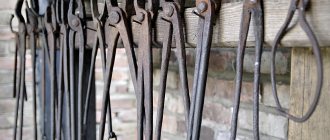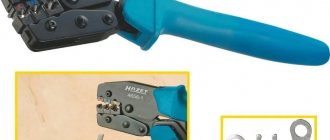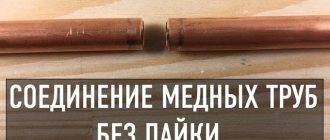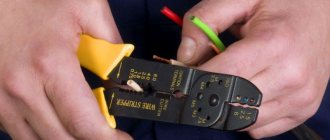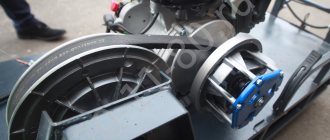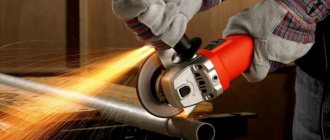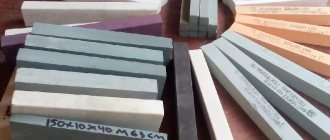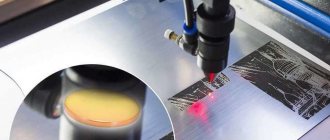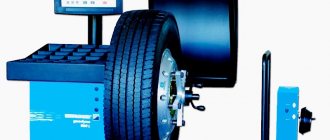Crimpers (also known as “tip pliers”) are a tool that is designed to make a contact connection at the end of a wire in a high-quality and proper manner, and at the same time, so that the transmission of electrical impulses through the wires occurs clearly and without failures. With their help, the required contact area is provided, however, to obtain a sufficient effect, it is necessary to correctly select both the matrix of the tool itself and various consumables.
IMPORTANT! Do not confuse the concepts of “sleeve” and “tip”. With the help of a sleeve, two ends of the wire are connected into one, and the tip is the end of the wire and provides for its connection to the terminal of a peripheral device. Terminals also include computer connectors and plugs for SCS networks and telephony.
Division of tools into household and professional
The use of crimpers is a very specific area that requires strict adherence to many rules and scrupulous adherence to precise technologies in the field of connecting wires. Any deviations from the standards and resorting to half measures will certainly result in damage to the connections made or broken contacts. Modern technological regulations (PUE and PTEPP) have long and categorically prohibited wire connections using cold twists. Therefore, the only correct way is to use pliers. However, not all crimpers will fit a certain type of cable cross-section, and they may not suit the purpose of the connection.
Depending on the type of actuation, pliers can be divided into manual (mechanical) and automatic (powered by an electric motor/hydraulics). Mechanical options can be both household and professional. Thus, using household samples, wires with a small cross-section are crimped: only 2.5 millimeters for aluminum and from 1 to 2.5 millimeters for copper. Professional mechanical pliers can work with large diameters and work on wires with a circumference of 4 millimeters.
But automatic pliers always have only professional use - only with their help is it possible to crimp multi-core wires with a large cross-section (up to 6 millimeters), which is usually in demand in industrial production conditions.
Crimping methods
Crimping of cable lugs involves crimping a stripped cable or wire into a special matrix using manual or mechanical tools.
Cable crimping sequence
This can be done:
- Full compression . This is the most reliable way to create a strong contact when connecting wires. Under the pressure created by a hydraulic press for cable lugs, the entire contact surface is compressed at once.
- Combined. In this case, the compression effect is enhanced by additional indentation of the punch, which has a working part in the form of a tooth.
- By pressing.
Cable crimping methods
On the diagram:
- a - local indentation.
- b - continuous pressing.
- c – combined crimping.
Besides:
- Aluminum wires are crimped with tubular or ring terminals, which depends on the thickness of the core.
Connecting wires
- Special sleeves are used for copper wires.
Ferrules for copper wires
- For multi-core wires, caps are used.
Tip: The size of the tip should be selected according to special tables, taking into account the thickness of the cable.
Features of production and design
A tip press will only be of high quality if certain standards have been met during its manufacturing process. A prototype of the device is always first developed and tested in specialized laboratories. The testing procedure consists of checking the following qualities of the prototype:
- The tightness of the resulting connection;
- Tensile strength of connection;
- General ease of use.
To launch a model of pliers into mass production, reliable, strong and durable manufacturing materials are specially selected to ensure the maximum number of press cycles. Today's market standard for a classic crimper is to perform at least 40 thousand pressings.
Modern types of crimping pliers for ferrules
The tools under consideration are used, as a rule, in two cases: to prepare conductive parts for fastening to the terminals of various electrical equipment and to connect cables and wires to each other. Thus, they can have two operating principles:
- By type of pliers;
- Diaphragm.
The first option is the most popular. The crimping process occurs by pressing two working jaws on the body of the tip with the wire. These crimpers differ from ordinary pliers by the presence of corresponding recesses on the working jaws, which guarantee that the consumables are firmly secured to the cable and establish the most reliable connection. The convenience of using pliers for crimping lies in the fact that there is no need to select the correct position of the consumable, since the action (top/bottom) can be performed from any side. However, you should carefully ensure that the tip fits the matrix (notches in the working jaws).
IMPORTANT! Before performing any electrical work on fixing the tips, you should make sure that the working tool matches the consumables. Possible problems can be avoided if you use a universal crimper with several different recesses for sleeves and section diameters.
The second option (diaphragm) press for lugs performs crimping from four or six sides, despite the fact that they themselves are able to adapt to the thickness of the cable section. This method is considered more reliable, since the crimp density increases significantly.
Directions for using crimping pliers
Crimping work can be sporadic or performed on an ongoing basis. For domestic use, the first option is typical, and it is unlikely that you will need to purchase a universal tool with a lot of auxiliary functions. In any case, classic crimpers should be used in the following areas:
- Crimping is standard - to perform this process you will need devices that may differ in the size of the matrix and the shape of the structure. Regarding the second condition, their body may contain a flange as an auxiliary element, with the help of which the connection will be of better quality.
- Removing the insulation layer - using pliers, it is possible to remove the desired section of the insulating coating, while preventing damage to the core itself. To perform this process, you must correctly set the length of the cutting element (there are models where this parameter is set automatically). Samples with a knife function are a little more expensive.
- Crimping of tips is special - for this process a special rod is used, which is placed on the dividing seam when performing the crimping procedure. Tools with this function are used when processing brass and bare wires.
- Working over twisted pair - with this procedure, the working part of the device must have a special recess for the connector.
Hydraulic press jaws
Such equipment is by far the most convenient and at the same time the most expensive. It allows you to perform most work in various areas with a minimum of effort. Hydraulic models consist of
- Handles;
- Working axis;
- Heads;
- Marking matrix.
This variation of crimpers can have either a closed or open head. In the closed type, first the stopper opens, then the matrix is pulled out, a wire with a tip is inserted into it, the structure is closed, and only then crimping occurs. In the open-head variation, no preparatory actions are required, which makes the entire work process much faster. Any model of hydraulic pliers can only be used for a certain range of cable cross-section diameters. The maximum size is 400 millimeters and is practically not used in everyday life. At the same time, hydropliers are convenient to use for crimping even small sizes (from 6 millimeters), the main thing is to prevent pinching.
IMPORTANT! If you intend to use hydraulic clamps with a wire made of very soft metals, then it is better to use a device with a limiter. This way the risk of pinching can be avoided.
The process of working with hydraulic clamps is quite simple. By swinging the pump piston handle and performing reciprocating movements, the required pressure is created in the housing, at which oil enters the working cylinder. The oil moves the cylinder, and it already creates pressure on the working matrix, which acts on the tip with a set force.
Historical perspective
Initially, as a tool, pliers were intended to remove hot metal blanks and crucibles of molten metal from forges.
They were also used by blacksmiths to hold various workpieces during forging. Archaeologists prove that the prototype of pliers - tongs, which had a rod-axis - was invented back in the Neolithic era. Back then this instrument was made from burnt wood. The first depiction of hand pliers tools dates back to the 6th-5th centuries BC. In the Bronze Age, blacksmiths used primitive pliers as clamps. They are currently found in the burials of blacksmiths as burial goods, indicating that the deceased had a special and fairly high social status.
Since ancient times, pliers have been two castor beans connected by a rivet that acts as an axis. This tool has been evidence of specialized blacksmithing skills since ancient times. Together with the anvil and hammer, pliers were an attribute of numerous ancient Greek and Roman blacksmith gods and lords of thunder (Thor, Vulcan, Hephaestus, etc.).
Much later, pliers began to be used in construction work, in plumbing activities, widely used in electrical work, etc. Depending on the specialization and principle of the device, various pliers are called side cutters, pliers, wire cutters, pliers, etc.
Features of crimping the ends of Internet wires (connectors)
Proper operation on any cable network will depend on several factors. First of all, this includes the quality of the wire itself. In second place is the degree of professionalism of network installers. In last place we can put the quality of connections in communications (however, such a gradation is clearly unfounded, according to many professionals).
It is contact, in most cases, that causes the transmission of an unstable or weak signal. To produce the most reliable connection, all system cables must be properly crimped using crimpers that can accommodate special connectors.
Any connection of Internet cables begins with removing the insulating coating. You can use a separate tool called a “stripper” for these purposes, or use a crimper with a built-in blade function. Thus, with the help of a cutting element, the insulation is stripped. Next you need to install the connector. In the modern world, most often, RJ45 connectors (Register Jack is a special network interface) are used for installing SCS (structured cabling systems). The body of this connector is slightly larger and in terms of connection performance is superior to the outdated RJ11. The latter cannot be used for computer networks and is only suitable for telephone communications. The crimping process itself is carried out according to a standard scheme: a connector is clamped into the working jaws of the device with the end of the stripped wire threaded into it, after which, with the application of mechanical/automatic force, crimping occurs.
How to use the tool
The technology of working with press jaws is simple and does not cause difficulties.
Safety regulations
Lighting must be sufficient. You cannot work at the limit of reach when you have to stretch - you need to come closer or change the scaffolding. Manipulations from ladders are not allowed.
Do not insert your fingers inside the head. Do not operate a faulty power tool. Do not allow the device to become contaminated, especially with oil, grease, water and other slippery liquids.
Do not carry the power tool by the power cord, yank the cord to pull out the plug from the socket, or carry the power tool while it is turned on (when the “On” button is pressed). Cleaning and adjustment of the power tool is allowed only when disconnected from the mains. Do not connect power tools using damaged cords (and plugs), or use unsuitable batteries. When working in wet areas, you should use battery models or extension cords with a residual current device (RCD). Do not use any power tool in wet areas or in the rain.
Preparing pipes for connection
Pipe preparation is the same for all types of pliers. Cut the workpiece to the required length using scissors or a hacksaw. Scissors are preferable - they leave an even cut without burrs. The cut must be strictly perpendicular to the pipe, there should be no jams, chips, or deformations. Before crimping the connection, remove burrs and clean the end of the pipe from dust and dirt. You can process the edge of the pipe with a calibrator and remove the chamfer.
How to carry out crimping with manual equipment
The fitting is disassembled, put on the pipe, the fitting is inserted inside the pipe until it stops, and the sleeve is pulled onto the section of the pipe with the fitting. There is a hole in the sleeve through which the depth of the pipe entry into the fitting is controlled.
Before crimping, open the handles of the press pliers 180° and check whether the nozzle matches the diameter of the fitting being crimped. Insert the fitting into the nozzle - the fitting sleeve must be in the nozzle exactly perpendicular to the plane of the pliers. With force, the handles of the pliers are brought together until they stop, which means that crimping has occurred. Open the handles and remove the fitting-pipe connection from the pliers. There should be two ring dents on the fitting.
All the details of the process can be seen in our video.
If the pipe and fitting are loosely or askew, the fitting union is loose, the crimping was carried out with insufficient force - the fitting will have to be cut off and thrown away, take a new one and carry out the crimping again. And at the same time, use another fitting to extend the pipe. Or take a new blank. Therefore, you should be careful when carrying out work. The peculiarity of press connectors is that they cannot be reused; the connection will be leaky. The system should be tested at its maximum operating pressure before starting up or paving/pouring concrete.
Tips for caring for press pliers
Always clean the pliers from dirt after finishing work with a clean, dry cloth. After use, check the attachment pin and the opening and closing of the attachment. The nozzle is a working tool and cannot be repaired. The damaged nozzle is thrown away. If necessary, lubricate the pin with silicone grease.
The pressing tool is stored in a dry room at a temperature equal to the operating temperature. Batteries are stored separately from tools and metal objects.
On hydraulic and electric models, every few years the pressure in the hydraulic system is checked, gaskets and filters are changed, and the crimping time is measured. These works must be performed by specialists.
Step-by-step mechanism of the crimping process
In theory it is not complex enough. The main thing is to have the right tool, suitable consumables and the ability to apply some muscular effort (if the crimper design is not automated). However, poor adherence to crimping technology can make the contact unstable, which will force the installer to repeat the entire procedure again. The sequence of the traditional procedure will consist of the following steps:
- Preparatory activities - at this stage you need to process the wire, remove the protective insulation from it using a cutting element, while leaving a margin of 3-5 millimeters. Separately, it is worth making sure that during stripping of the coating, the load-bearing core was not damaged. If damage is found, then such a section will have to be cut off completely.
- Preparing the connection - a sleeve/tip or connector is put on the wire, while the open part of the cable must be degreased or a special paste is applied to it (for SCS cables);
- Preparation of the tool - the required cross-section and tip size are set in the pliers matrix (the tip is inserted until it stops).
- Direct compression - pressure is applied to the working handles of the device or its hydraulics are started. When a characteristic click appears, the process is considered completed. The handles of the device return to their original position.
- The final step - if necessary, the remaining section of braid is returned to the joint and heated with a hair dryer (or other tool).
Technology
- Remove the insulating layer by 2-3 cm from the wires to be connected.
- Now, using fine-grit sandpaper, sand the bare areas to a metallic shine.
- If the conductors are aluminum, apply quartz-vaseline paste to them, if copper, then technical petroleum jelly.
- When crimping on one side, place the wires parallel to each other and put a sleeve on them. For double-sided applications, insert the stripped wires into the tube from opposite ends to the joint.
- Crimp the connection with press pliers, wipe with a cloth soaked in gasoline or solvent, insulate with electrical tape, heat-shrinkable tubing or varnished cloth.
The wiring in the junction box using crimping is shown in detail in this video:
As you can see, there is nothing complicated in crimping, and you get a reliable and high-quality connection. If you need to do similar work of a one-time nature, you can ask someone for press pliers or rent them. If you often deal with electrical installation work, buy a tool, it is not too expensive.
Difficulty of choice
In order to correctly select pliers for crimping lugs or special crimpers for connecting cables of SCS systems, you need to pay attention to the following tips:
- Selecting a device begins with a clear definition of the tasks for which it will be used. It is from this generated list that it is necessary to select both the functionality and dimensions of the press jaws. If you have to do not one-time, but permanent work, then universal equipment will be the best choice.
- Not the last criterion will be the price, on which the performance of the equipment will depend. Naturally, world-famous brands are considered a guarantee of quality. If the cost of the device is low, then it is unlikely that you will have to count on its long service life.
- At the time of purchase, the device must be checked for defects, and at the same time, the overall build quality of the structure must be assessed. First of all, you need to pay attention to the presence of all kinds of dents and chips, and also check the accuracy of the contact of the jaws and the position of the handles.
- Special attention must be paid to the shape of the handles. If they have special recesses, they will help to hold the device more securely in your hands.
- Also, it won’t hurt to simply hold the device in your hand - all possible inconveniences associated with weight or shape will immediately appear.
What kind of instrument is this
Press pliers are a special device for connecting press fittings to metal-plastic (and plastic) pipelines. Press fittings are pressed onto the pipe using pliers and form a reliable sealed connection. The press connection does not require further regular inspections, tightening or tightening. If the fitting is installed correctly, the system will not leak for many years. For pouring into grooves and screeds, only press fittings are allowed.
There are varieties for crimping cable ends into lugs, securing terminals and connectors to wires.
Rating of the best pliers for crimping tips (crimpers) for 2021
Budget segment
3rd place: “ZUBR Expert 22668-23”
This model is a bright representative of an inexpensive and at the same time universal crimping tool. The working part is designed in such a way that it allows you to perform a variety of works with wire cables. The tool is perfectly suited for stripping insulation and carrying out stripping at a finishing level, at which the risk of damage to the core itself is minimal. Capable of crimping insulated/non-insulated ferrules and even cutting brass bolts. The recommended price for the retail network is 520 rubles.
BISON Expert 22668-23
Advantages:
- Durability of the structure;
- Control comfort;
- Multifunctionality.
Flaws:
- Not detected.
2nd place: “PROconnect HT-568R 8P8C, 6P6C 12-3432-4”
A good tool, however, it requires some experience to handle it more accurately. The design includes a scoring knife, which must be properly adjusted before use. During the crimping process, the matrix protrusions clearly rest against the contacts, and not against the connector partitions, which makes the entire operation more productive. Indentation occurs evenly along the entire contour. The recommended price for retail stores is 690 rubles.
PROconnect HT-568R 8P8C, 6P6C 12-3432-4
Advantages:
- High quality crimping;
- Adequate cost;
- Matching matrix pressure.
Flaws:
- Fine adjustment of the scoring blade is required.
1st place: “Hyperline HT-210C 3446”
Specialized crimper for working with RJ45 cables in structural cable systems. With its help, it is convenient to crimp modular connectors. Can also be used for stripping conductors and cables. The working part is made of medium carbon steel, which means proper strength of the device and a relatively long service life. Operating structural elements are covered with black chrome plating, which guarantees resistance to corrosion, while simultaneously increasing the wear resistance of the device as a whole. The working range of cables is from 5 to 11 millimeters in diameter. The established store price is 860 rubles.
Main types of ticks
Crimping pliers are divided into two types. The most common type is a design that works like pliers. That is, the sleeve is compressed on both sides. Other pliers are diaphragm crimpers.
Passatizhny
The tip is crimped in the same way as pliers grip a part. The working surface of the dies has cutouts into which the tip shank is threaded. This design is suitable for those fastenings that do not require special reliability.
To increase crimping force, hydraulic ferrule crimping tools were invented. Thanks to this improvement, the pliers became more efficient. The design uses cylinders with pistons filled with oil, which creates a large pressure of the matrices on the tip sleeve.
Important! Some crimpers are equipped with several types of removable matrices. The versatility of the tool eliminates the need for pliers for each conductor cross-sectional size.
Diaphragm pliers
The originality of the design of diaphragm crimpers lies in the comprehensive coverage of the tip shank. The principle of operation is similar to the movement of the aperture blades of photographic lenses. The only drawback of such devices is the impossibility of inserting pliers into the connection of the two ends of the wires.
Note! The diaphragm tool is used as a press for pin or flat metal tips. The all-round clamp is much more effective than the plier type for covering the end switches of wire products.
Instead of an epilogue
Based on the analysis of the market for the instruments under consideration, it was established that almost all of its niches are occupied by models from a foreign manufacturer. If in the budget segment you can still find Russian samples, with fairly good characteristics and at a normal price, then at higher levels they simply do not exist. At the same time, it is worth noting that the entire premium segment is completely “occupied” by samples from the German company. This brand has existed since 1885 and it is not surprising that it managed to completely capture the top positions. However, the price of Knipex tools is very “biting” - it is simply impossible to find their crimper-type device specifically for tips with a price of less than 10,000 rubles. However, if such a crimper was nevertheless found, then it is essentially a banal fake.
